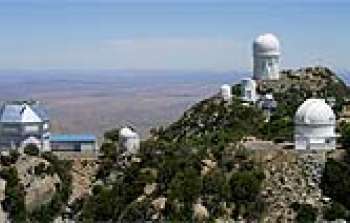sci11006 — Announcement
Dire Budget Projections from NSF AST: Your Input Needed
September 30, 2011
In his presentation to the Astronomy and Astrophysics Advisory Committee, NSF AST Director Jim Ulvestad provided guidance on the NSF MPS Astronomy (AST) budget projections that can only be described as dire. The signals from NSF AST imply that some existing facilities will be closed and some popular programs eliminated as a result of budget pressures, significantly altering the landscape of ground-based astronomy.
The possibility of drastic changes calls for careful planning and consultation with the community so that US ground-based OIR astronomy emerges stronger rather than crippled by this process. Please read the following and join a discussion on how we as a community can best meet these budgetary challenges.
Budget Outlook
In contrast to the brighter view considered in the 2010 Decadal Survey, which anticipated growth in the NSF AST budget of 2-4%/yr, NSF AST funding is likely to decline by 4% or more in fiscal year 2012 (slides 13, 17) and by substantially more (5-10% or more, slide 14) in 2013.
With NSF AST’s current emphasis on protecting funding for facilities with interagency and international commitments (Gemini, ALMA) and the scheduled ramp up in ALMA operations costs (from approximately $18M/yr currently to approximately $30M in 2012 and $34M/yr in 2013; slide 26), the decline in the NSF AST budget would have a much greater impact on the non-protected programs. For example, the NOAO budget may decline by 10-20% in each year under these conditions.
As the NSF Major Research Equipment and Facilities Construction (MREFC) budget is expected to remain flat at best (slide 13), no funds are currently available for the construction of new facilities such as the Large Synoptic Survey Telescope (LSST). Thus LSST will require “bridge funding” of the order of $5-10M/yr starting in 2013 to keep the LSST Project going while it waits for NSF construction funding to become available, possibly in 2014 or later (slide 20). Bridge funds would also come out of the NSF AST budget (slide 20, 26).
Given the above budget pressures, there is little likelihood of increased funding for popular programs such as ATI and TSIP (slide 22). These programs may instead be eliminated and programs such as ReSTAR not completed. (Note that TSIP has already been zeroed out for 2012 as previously announced by AST.)
Impact on Existing Facilities
We can infer the very real possibility that NSF AST may choose to close KPNO and possibly other NOAO facilities or sites as open access resources in response to the above budget pressures (slides 8, 15, 26), negating years of community planning, as well as the real progress that NOAO has made in responding to the needs of our community.
In short, in response to community input to the 2006 NSF Senior Review, NOAO rebalanced its program to rejuvenate the smaller aperture facilities (4-m and smaller). Based on the guidance of the community (via the ReSTAR and other committees), new instruments are being built and commissioned for these facilities (e.g., COSMOS, KOSMOS, TripleSpec, etc). We have initiated partnerships with the community to bring powerful cameras and spectrographs to the Blanco (DECam) and Mayall (BigBOSS) telescopes. These instruments will carry out cost efficient frontier science programs that were highly ranked by the 2010 Decadal Survey, as well as enable a host of other discovery science programs. The science gains from these investments will be lost if the facilities are closed.
Let us know what you think!
Given the tight budget situation and the existing commitments to ALMA and Gemini, difficult choices and sacrifices will need to be made within the AST portfolio, both to ensure that the current program remains viable and to enable the 2010 Decadal Survey recommendations. Because of the budget pressures, significant changes may be made even before the AST Portfolio Review is completed in summer 2012 (slide 26).
The possibility that near term sacrifices may significantly alter the current landscape of ground-based OIR astronomy calls for careful planning and consultation with the community so that US ground-based OIR astronomy is not crippled by this process, and the emerging vision from the Portfolio Review has a strong base from which to build.
We have created an online community forum to enable such a discussion. Possible discussion topics include the following.
-
One of the NSF AST’s principles for budget decisions is to “maintain a robust individual investigator program to enable a broad base of astronomical research across the country” (slide 26). NOAO’s open access policy enables such a program. How important are NOAO facilities and programs to your research and education programs?
-
Protecting funding for existing international commitments within a flat or declining NSF/AST budget means fewer dollars for ground-based OIR astronomy. Since AST’s budget is declining in real terms, some of these dollars are leaving astronomy all together. What are your priorities for how the remaining dollars should be spent?
Comments entered at the website will be posted immediately. Comments sent to currents@noao.edu will not be posted unless requested. We look forward to hearing your thoughts.
Contacts
currents@noao.edu
About the Announcement
| Id: |
ID
sci11006
|
